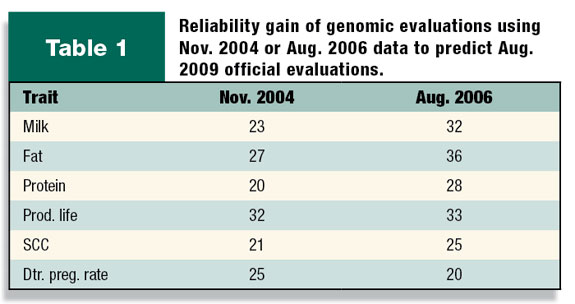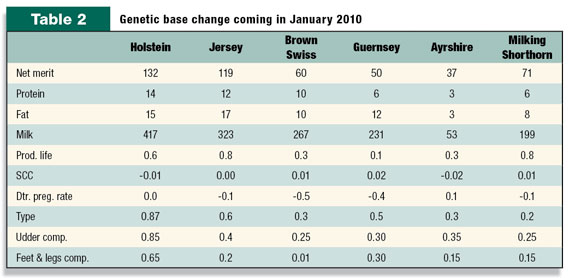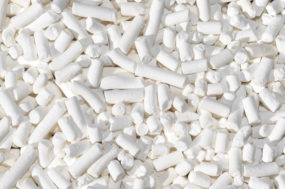The A.I. industry has been immersed in an exciting time with the introduction and refinement of some of the industry’s greatest technological advancements over the past several years. Let’s take a look at where we stand with sexed semen and DNA marker technology, possibly two of the most impactful advancements in the industry – and what is to come as we enter 2010.
Sexed semen
The present dairy economy has reduced the demand for sexed semen with dairy producers focusing attention on the bulls they really want replacements from versus the use of sexed semen just to generate more heifers. Changes in the supply and demand for conventional semen from elite, high genetic merit sires, makes sorting these sires to provide dairy producers better genetic choices more economically feasible than when sexed semen first became available in 2006. Irrespective of service sire genetic merit, a common reason given by dairy producers to justify their use of sexed semen is the value of heifers having heifers instead of bull calves. The economics associated with reduced calving problems are very difficult to calculate or estimate but over and over this has been cited by producers as a real and tangible value of sexed semen. A new sexed semen option of 75 percent X-chromosome-enriched semen versus the initial 90 percent X-chromosome-sorted semen is now in the market place. This product uses identical sorting procedures to the 90 percent product but simply “opens the gates” to allow more male sperm to enter the retained sample. The 75 percent product is packaged at the same sperm concentration as the 90 percent product, so conception rates will be very similar. This option is less expensive because yields are enhanced by retaining more than twice as many Y-bearing chromosomes, thus allowing the production of more straws per unit of time.
Many herds that have used sexed semen for years are still using it, but are now being more selective about which heifers they choose to mate with sexed product. Many producers are using sexed semen on first-lactation, high index cows in good standing heat. Conception rates in cows are reduced by a similar magnitude as previously seen in heifers (approximately 75 to 80 percent of conventional). Commonly conception rates for heifers decrease from about 60 percent with conventional to 45 to 48 percent with sexed whereas for cows, 33 to 35 percent with conventional becomes 25 to 28 percent with sexed. Another important point that must be mentioned is the conception rates of conventional semen usually range seven percentage points across the population of bulls using conventional semen. In contrast, the conception rates for these same bulls with sex-sorted semen can range 20 percentage points from the highest to lowest. Because all sexed semen released for sale must pass the same stringent post-thaw semen quality evaluations, this variance in sire fertility is believed to be largely due to differences among bulls in their ability to maintain acceptable levels of fertility at the low sperm number dosages dictated by the sex sorting procedure. Thus, the recommendation is to use sexed semen from a variety of bulls to reduce the risk of a low conception sire.
We continually collect conception data from herds using gender SELECTed semen to calculate sexed semen fertility deviations and removes bulls from the lineup that perform unacceptably. This data is also used to help further our understanding of post-thaw semen quality attributes that may allow us to better predict sire conception potential using sex-sorted
semen.
Though demand is down, sexed semen will continue to be a tool for dairy producers to generate a higher yield of heifer calves. Today’s economic environment simply dictates that sexed semen be used more selectively on females that are most desirable for herd replacements.
Accuracy of genomic evaluations
We are now nearly a year into using DNA information in calculating USDA genetic evaluations. Using DNA test results in the evaluations substantially improves their accuracy for heifers, cows and young A.I. sires. The DNA test results come from the Illumina Bovine SNP50 chip, which tests for 50,000 DNA markers and costs about $250.
Using this large amount of DNA marker information in a meaningful way in genetic evaluations is breakthrough technology. It requires a large historical database of tested animals. Because of these large database requirements, North America is one of the few places in the world with access to these evaluations. The USDA genomic evaluations use historical results from
over 6,500 genome-tested proven bulls to predict the future performance of younger animals.

Now that we’ve used the system for awhile, we are developing a track record of how well the evaluations work. Through several rounds of validation testing, the results show that the genomic evaluations work and deliver the improved accuracy they promise. Table 1 shows recent research results comparing genomic evaluations as they would have looked in 2006 to actual daughter performance observed in 2009. In addition, it appears the accuracy of the genomic PTAs are gradually improving as more and more genome-tested A.I. sires receive progeny proofs.
Genomic evaluations are new technology and many researchers are working to find improved evaluation methods. In January, USDA will implement slightly revised methods for computing genomic evaluations. These new methods only have a small impact on accuracy but do a better job of producing less biased evaluations. Under the new system, genomic evaluations on the breeds’ most elite animals remain somewhat inflated but not as over-evaluated as they were in the previous system. You may notice a small decrease in the January evaluations for the top bulls. On average, the top genome-tested young sires are over-evaluated by 50 to 100 NM$.
Genomic evaluations make it possible to make better use of high-ranking young sires. However, genomic evaluations aren’t yet accurate enough to pinpoint the exact individuals with truly superior genetics. Progeny testing is still required to reach this level of accuracy. Producers that desire to be on the cutting edge of genetics should make use of genome-tested young sires. However, when doing this, make sure a group of bulls are used and not large amounts of any one individual bull. For producers that want consistent and predictable results, progeny-proven sires are still the best choice.
Genetic base change coming in January 2010
Every five years the USDA updates the base used for genetic evaluations. For an easier comparison, dairy cattle evaluations are expressed in a relative way to a base population that has known performance levels. By adjusting the base numbers every five years the base remains fairly similar to the level of the current cow population.
The next base change is right around the corner, set to take effect in January 2010. This new base will use cows born in 2005 (produced by matings made between April 2004 and March 2005) as the reference point for establishing the standard. When the new numbers are implemented, the relative ranking of each animal will not change. But the PTA values for most traits will be lower because each animal is being compared to a more modern base population. This practice is in place to keep PTAs from growing larger over time. It also assures that the PTA values for A.I. sires provide realistic indications of the differences you will see in their daughters.

The base change is a convenient time to analyze the amount of genetic progress made in the last five years. Values in Table 2 indicate the amount PTAs will decrease between the August 2009 evaluations and the January 2010 version. They also indicate the amount of progress each breed has made. As you can see, especially for Holsteins and Jerseys, nice progress has been made in increasing production levels, improving udder and feet and legs conformation, improving longevity as well as increasing overall profitability. PD





